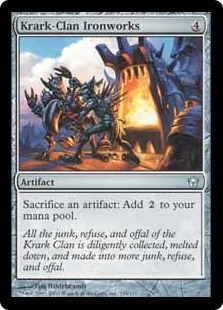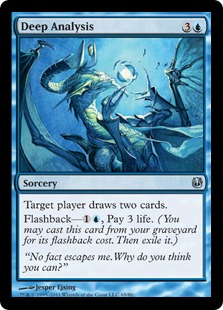A few common questions frequently come up in conversation about relics and older cards; why would anyone spend so much money on one card? Moreso on a card they can't use!
The Magic community is very different from other trading card games with a notoriety and history that spans almost two decades, a Pro Tour circuit, and dozens of different formats to enjoy. The community has huge Magic personalities including Evan Erwin of The Magic Show, Sheldon Menery in Embracing the Chaos, and Luis Scott-Vargas of Channelfireball; not to mention a plethora of podcasts and articles across the internet.
A simple player in the community is multi-faceted; having qualities that can span from a casual player dabbling in Planechase to a PTQ/GP grinder. Most players can't be exclusively categorized into just one dimension of a Magic player. Many players play the game as well as collect cards. Show of hands; how many of us have cards that we keep because they have special memories? A lot of us have cards we keep safe because we obtained them through an awesome trade, an epic pack, or even first cards we used to start learning the game. There's an inherent, emotional aspect tied to the game and the cards you collect because of the game's history and the stability of its fan base. This stability ensures that precious cards will remain coveted and, well, precious.
Collecting also has a huge financial incentive. Holding on to older cards has been a huge advantage to collectors over the past couple years, where eternal format staples have been steadily climbing in price as demand for these cards greatly exceeds availability. The recent EDH boom and the loss of Extended and heightened interest in Legacy, older cards are being sold at premium and it becomes increasingly more difficult for newer players to get their hands on them. Fortunately for new players, WotC continues to produce promotional product that has many reprints of very powerful cards; a good example being Entomb in the new Graveborn product. A card almost unobtainable a few months ago is now widely available (and in foil!) for players to put a copy in their EDH deck or to start picking up Legacy. The problem with reprinting cards are the loss of value of players who spent the $35+ on their copies of Entomb before the reprint or for those who were holding the card with the incentive that the card would increase in price. Unfortunately, playing the financial game in Magic is tricky and dangerous. Sometimes projecting the value of a card based off of play in a format can be completely undone by a promotional product reprint. It's the risk you take with collectible items. Fortunately with relics, you have the Official Reprint Policy by WotC that prohibits the reprinting of revised dual lands and the Power 9 (among other older cards). This policy ensures the value and financial security of investing into older relics and helps me keep a piece of mind as I start making difficult choices into the power hunt. For the revised dual lands, they're the best of the best of fixing mana and will always be the best lands every printed in the game. Since they sit nicely on the reserve list, they prove to be a fine collector's item that can only increase in value as long as the Magic community continues to thrive.
Now on to the relics. I started researching the cost and availability of Power 9 across many websites and local stores. As you can imagine, a lot of locations don't have them. Very few areas in my region have any in stock, so I had to branch out. Since you don't really know when or where a piece of power may show up at a good price, I started investing cards into Channelfireball.com, since they consistently have relics available and sometimes get played versions in stock.
4x Darkslick Shores
4x Mental Misstep
1x Foil Lashwrithe
1x Solemn Simulacrum
1x Jace, Memory Adept
1x Grave Titan
1x Chandra, the Firebrand
2x Liliana of the Veil
1x Kessig Wolf Run
1x Garruk Relentless
1x Surgical Extraction
I moved the following for a little over 180 in store credit to use at my liesure. The trick to getting so much credit for a small amount of cards is simply demand. I started hunting the buy prices about a week before Worlds when demand would be at its highest since rumors and speculations about certain decks would cause some cards prices to spike. Usually before the larger tournaments, cards don't decrease, so you're usually ok selling whatever card it is. Look at Olivia Voldaren, hitting an impressive average of $16 during Worlds and now settles around $11. Setting your buys after a major event is a huge waste of time, since the 'rumored' decks will either have disappointed or the people who played at worlds are saturating the market with the cards they don't need anymore.
Since then, I used some of the credit to fund an EDH deck I've been inspired to build featuring Sedris, the Traitor King. So much for saving it for a piece of power. I got anxious. Along with the construction of my deck, I also picked up this awesome land.
Savannah: valued at $65.82
About a month later, I started consolidating most of my trade binder and looking at everything left. My trade binder which had been bountiful and stocked was now small and barren. I was very proud of myself for comign this far and there were only two standing in my way.
The last two were a bit of an oddity, with a bitter sweet ending. I was checking the Coolstuffinc.com website and I saw a beautiful Mox Ruby up for sale. I looked at my trade binder one last time and thought I could make it happen. Flipping over an entire binder for 8 lands and a Mox would be an absolutely awesome feat. I took a couple friends and my girlfriend with me to go check out the trade and for some moral support; after all, flipping over $350 worth of cards is going to be painful. After setting up the buy cart for about 2hrs, my friends were getting antsy and started to complain. In hindsight, I can't blame them, but at the time, I only had that Mox in mind. After setting and resetting the buy cart several times, I came to the unfortunate conclusion; I could not get the Mox. After being about 50 dollars short, I conceeded to the fact that this Mox would again be the fish that got away. After going through the buy cart and taking out the few cards I genuinely wanted to keep, I hit just enough to breach 100 bucks. I settled with picking up the last Scrubland and 1 played Plateau. Unfortunately, I again forgot to take a picture of the trade and was very disappointed that I couldn't get the transaction in a photo. In the end, most of the trade binder had been flipped with the exception of a few money cards. Hopefully, I'll get lucky at Grand Prix Orlando in 2012.
I was really excited to finally have finished the set of 10, but disappointed that most of my Power trades have fallen through. I feel very accomplished, but that there's still more growth to be done and I'm anxious and excited to start tackling Power trades. For the next trades, I'll have to do them more independently, so I don't have to factor in wasting others' time, which I do feel bad about (I almost feel like I'm hunting horcruxes). Thank you to everyone who supported me and look forward to Part 2 and the hunt for Power. I hope you all enjoy the holidays with friends and family and I hope Santa brings you guys relics under the Christmas tree.
Merry Christmas to all; and to all, a good night.
10 Revised Dual Lands: valued at $697.24
-David J.
Follow us on Facebook!































